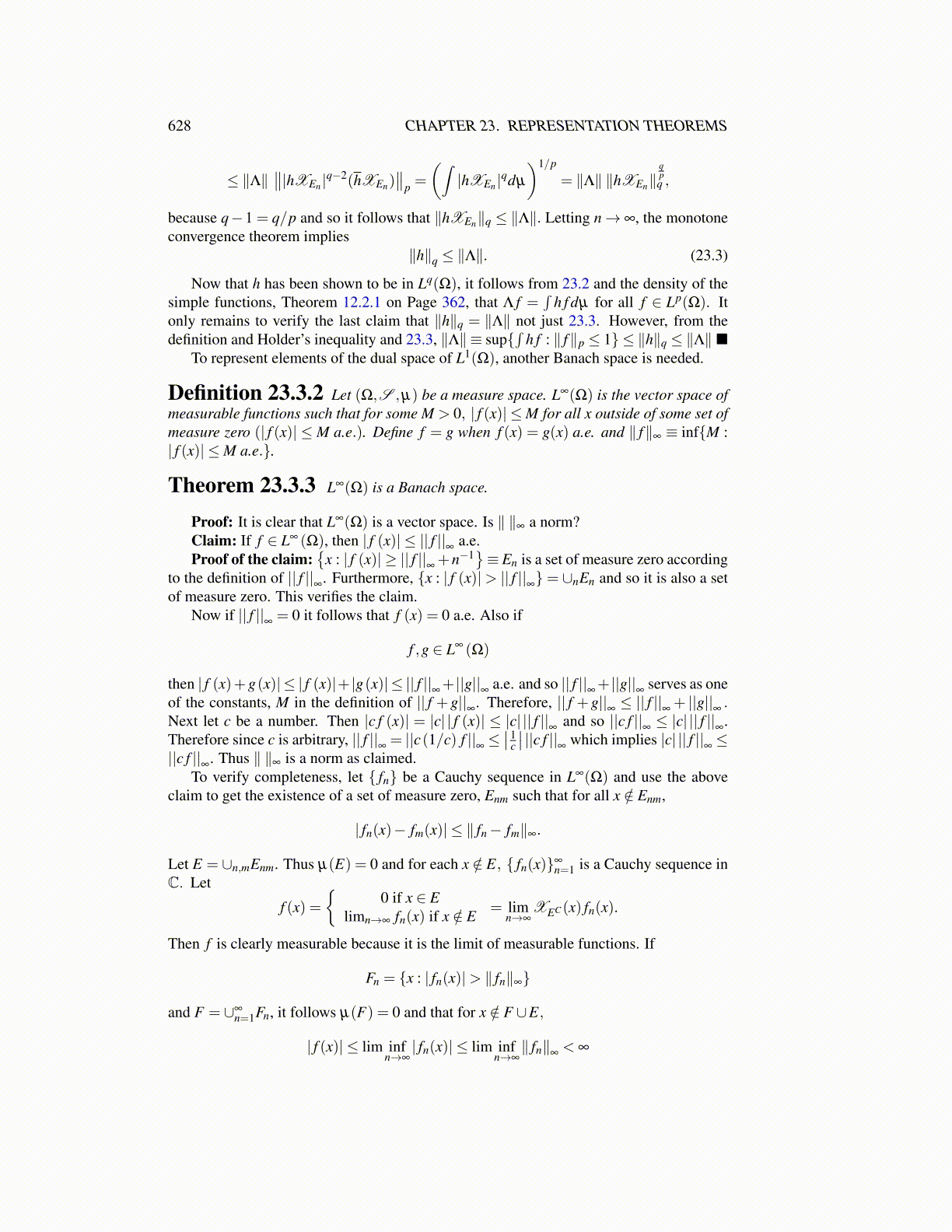
628 CHAPTER 23. REPRESENTATION THEOREMS
≤ ∥Λ∥∥∥|hXEn |q−2(hXEn)
∥∥p =
(∫|hXEn |qdµ
)1/p
= ∥Λ∥ ∥hXEn∥qpq ,
because q−1 = q/p and so it follows that ∥hXEn∥q ≤ ∥Λ∥. Letting n→ ∞, the monotoneconvergence theorem implies
∥h∥q ≤ ∥Λ∥. (23.3)
Now that h has been shown to be in Lq(Ω), it follows from 23.2 and the density of thesimple functions, Theorem 12.2.1 on Page 362, that Λ f =
∫h f dµ for all f ∈ Lp(Ω). It
only remains to verify the last claim that ∥h∥q = ∥Λ∥ not just 23.3. However, from thedefinition and Holder’s inequality and 23.3, ∥Λ∥ ≡ sup{
∫h f : ∥ f∥p ≤ 1} ≤ ∥h∥q ≤ ∥Λ∥ ■
To represent elements of the dual space of L1(Ω), another Banach space is needed.
Definition 23.3.2 Let (Ω,S ,µ) be a measure space. L∞(Ω) is the vector space ofmeasurable functions such that for some M > 0, | f (x)| ≤M for all x outside of some set ofmeasure zero (| f (x)| ≤M a.e.). Define f = g when f (x) = g(x) a.e. and ∥ f∥∞ ≡ inf{M :| f (x)| ≤M a.e.}.
Theorem 23.3.3 L∞(Ω) is a Banach space.
Proof: It is clear that L∞(Ω) is a vector space. Is ∥ ∥∞ a norm?Claim: If f ∈ L∞ (Ω), then | f (x)| ≤ || f ||
∞a.e.
Proof of the claim:{
x : | f (x)| ≥ || f ||∞+n−1
}≡ En is a set of measure zero according
to the definition of || f ||∞
. Furthermore, {x : | f (x)|> || f ||∞}= ∪nEn and so it is also a set
of measure zero. This verifies the claim.Now if || f ||
∞= 0 it follows that f (x) = 0 a.e. Also if
f ,g ∈ L∞ (Ω)
then | f (x)+g(x)| ≤ | f (x)|+ |g(x)| ≤ || f ||∞+ ||g||
∞a.e. and so || f ||
∞+ ||g||
∞serves as one
of the constants, M in the definition of || f +g||∞
. Therefore, || f +g||∞≤ || f ||
∞+ ||g||
∞.
Next let c be a number. Then |c f (x)| = |c| | f (x)| ≤ |c| || f ||∞
and so ||c f ||∞≤ |c| || f ||
∞.
Therefore since c is arbitrary, || f ||∞= ||c(1/c) f ||
∞≤∣∣ 1
c
∣∣ ||c f ||∞
which implies |c| || f ||∞≤
||c f ||∞
. Thus ∥ ∥∞ is a norm as claimed.To verify completeness, let { fn} be a Cauchy sequence in L∞(Ω) and use the above
claim to get the existence of a set of measure zero, Enm such that for all x /∈ Enm,
| fn(x)− fm(x)| ≤ ∥ fn− fm∥∞.
Let E = ∪n,mEnm. Thus µ(E) = 0 and for each x /∈ E, { fn(x)}∞n=1 is a Cauchy sequence in
C. Let
f (x) ={
0 if x ∈ Elimn→∞ fn(x) if x /∈ E = lim
n→∞XEC(x) fn(x).
Then f is clearly measurable because it is the limit of measurable functions. If
Fn = {x : | fn(x)|> ∥ fn∥∞}
and F = ∪∞n=1Fn, it follows µ(F) = 0 and that for x /∈ F ∪E,
| f (x)| ≤ lim infn→∞| fn(x)| ≤ lim inf
n→∞∥ fn∥∞
< ∞